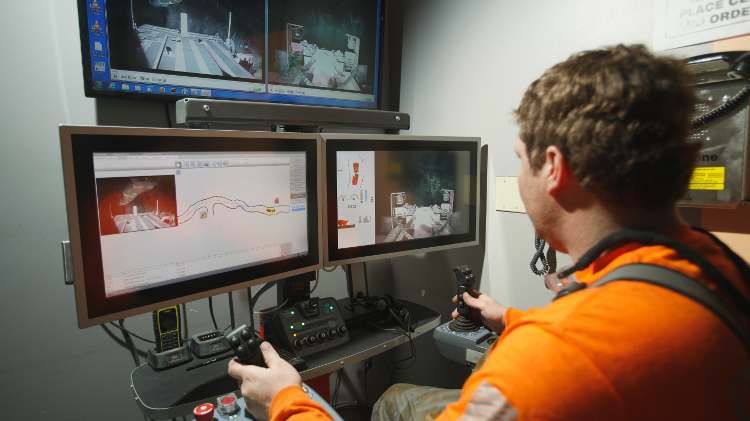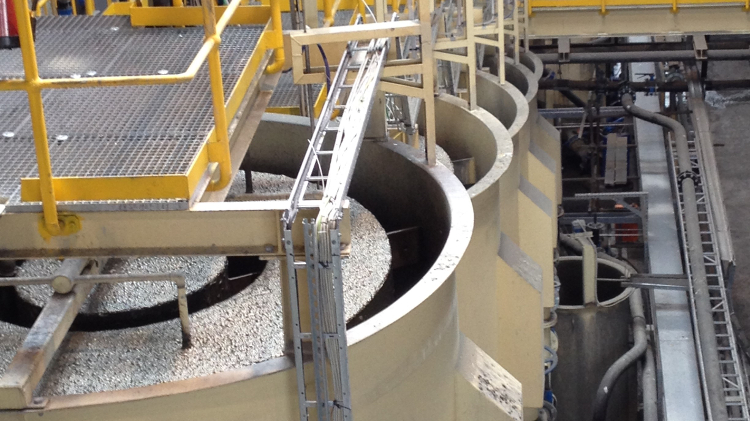By the end of the year, there will be nine drills outfitted with the autonomous operating system. Courtesy of ArcelorMittal
Four years ago, ArcelorMittal Mining Canada G.P. began to explore switching over to an autonomous drilling system (ADS) at its Mont-Wright iron ore mine in the North Shore region of Quebec. With 11 drills by different manufacturers and numerous practical challenges, this was not going to be an easy task.
The company determined a 24/7 autonomous system was not their ideal end goal for Mont-Wright at this moment and instead they explored the opportunities of partial autonomy.
The mine’s electric drills operate 21 hours a day. The remaining three hours are lost to operator breaks and shift changes. “Three hours a day represents a decent chunk of time where your drill could be drilling,” said Saad Hameed, director of operations for the IROC and co-lead for the ADS project. “We wanted to recover structural downtime.”
Enter Caterpillar
With four different types of drills by two manufacturers and only seeking partial use of autonomous drilling to increase Mont-Wright’s productivity, ArcelorMittal did not want a costly complete retrofit of all the drills. “You would basically redesign most systems on board if you did that,” said Hameed.
The solution they needed did not exist. From a technological perspective, the interoperability issue – in this case, the ability of a new third party system’s software to communicate with the original equipment manufacturers’ (OEMs) onboard control systems – was a formidable challenge.
ArcelorMittal decided to work with Caterpillar, which has been working on autonomous drilling for years and introduced its first such system in 2012, in order to develop a new technology to overcome this challenge.
“We have customers around the world that have interest in autonomy,” said Jim Peterson, mining technologies application specialist at Caterpillar. And although Caterpillar believes its drills are the best solution, said Peterson, it also wanted to develop options to help all potential customers looking to introduce autonomous drilling into their operations.
“So that’s the goal of this project: to be able to provide the same benefits to customers with different products,” said Peterson.
The new technology
OEMs periodically introduce upgrades and improvements to the programmable logic controllers (PLC) on board their equipment. This meant that the interoperability challenge would not be a one-time issue. “You don’t want to disrupt the autonomy because the PLC has had an improvement or enhancement,” said Peterson. Conversely, Caterpillar also wanted to ensure customers could still benefit from the ongoing improvements OEMs provide to their customers.
The solution they developed was to essentially bypass the challenge by developing a layered system that does not alter the onboard system. The new technology begins with an innovative new bolt-on interface that leverages the base machine’s controls, then adds Cat Terrain’s high-precision satellite positioning system, which determines the placement, depth and angle of holes in a single row using guidance software.
Related: What is the best way into the automated future?
The system also has an autonomous technology layer as well as a remote assistance layer. Instead of replacing the onboard controls, the new system’s computer provides a virtual operator.
On an offboard tablet, an operator can manage and monitor the virtual operator’s autonomous drilling.
“It’s a non-intrusive system so in case it fails, the [human] operator could continue to do their job with the drill’s onboard system,” said Hameed, who added that it is also considerably less expensive than a traditional retrofit.
The system is scalable so if in the future ArcelorMittal decides to add more autonomous features, it will be able to do so. “You can keep an operator in the cab but you still have all the autonomous factors,” said Peterson. “You then can move your operator out of the drill to operate it remotely.”
Going live
In October 2015, the team installed the Cat ADS bolt-on system on one drill. Over the following year, ArcelorMittal assessed the performance of running the drill during breaks and shift changes. The assessment confirmed the new system resulted not only in improved productivity but also in higher drilling quality and rates. In 2017, the system was installed on two more drills.
There were some unexpected benefits as well. “We’re also seeing additional performance for operators who can now leave the drill when their help is needed somewhere else and come back,” said Michel Plourde, director of innovation and technology for the Integrated Remote Operations Centre (IROC) at ArcelorMittal and lead on the ADS pilot project. “They’re happy and they are getting other things done. We wanted to help people understand that this is a technology that is there to assist them, to enhance their work, and that becoming an autonomous drill operator themselves is a job enhancement.”
Related: Rio Tinto’s Stephen McIntosh is overseeing the transformation of the company’s operations through automation and advanced technologies
Today, five drills have the Cat ADS bolt-on system. By the end of this year, that number will grow to nine, and the project will be complete, since two of the drills are near the end of their life cycle and will be retired. The increase in productivity will make it possible for Mont-Wright to continue operating without having to replace the two drills. Even with partial autonomy, ArcelorMittal has noted that the more the autonomous system is used, the greater the reduction in wear and tear on the equipment. “With autonomy, you get a steady productivity and there’s a really good chance you will reduce maintenance costs,” said Hameed.
“There’s a double whammy benefit there,” said Plourde. “One is the reduction in maintenance and the second is reduction in production variability.”
Reduction in variability is automation’s sweetest spot. “The company’s leadership and innovation strategy is moving toward lower variability and a smoother operation,” said Hameed. “So how do we control variability? This project fits really well with what our strategy is.”
Next steps
Caterpillar is now adding the new ADS technology to its electric and diesel drills. “A site with diesel or electric drills can have the same autonomous capabilities now,” said Peterson. “Customers don’t have to take an all-or-nothing approach to automation. There is a lot of change management that needs to go into taking a manned operation into an autonomous one. We have about five building blocks on these drills to build up autonomous technology.”
From ArcelorMittal’s perspective, the project confirmed its strategy of partial automation. “We were able to confirm that these apparently small gains with the addition of partial autonomy were actually quite important and really worth it,” said Hameed. “So much so that it pays for itself very quickly.”




